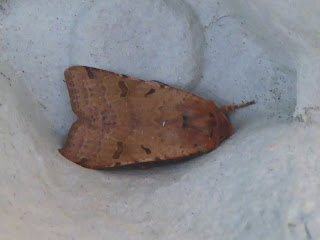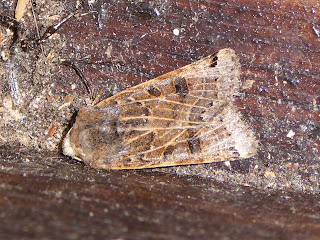Sightings and news for the Naturewatch group of Great and Little Abington in Cambridgeshire, UK. See below for more details and information on how to join.
Friday, 21 October 2016
Tree Sparrows in Cambridge Road (and Buzzard)
Wednesday, 5 October 2016
Observe bio-security - clean boots and equipment if you visit other rivers!
World Rivers Day - celebrated at Abington Woods on 24 September
Deborah set up some displays and activities, aimed mostly at her young customers, at Abington Woods. There are some photos here: https://flic.kr/s/aHskEaCter.
Monday, 3 October 2016
Wasps around!
Mushrooms around!
I've also seen them around in other places nearby.
Saturday, 1 October 2016
Moths in Church Lane
There was a reasonable selection of mostly 'little brown' moths and one or two other insects!
Thanks for Mike and Lois Bull for the tentative identifications below - all Noctuids, the largest family of moths:
 |
| Smoky Wainscot |
 |
| Smoky Wainscot |
 |
| Barred Chestnut |
 |
| Bordered Gothic |
 |
| Setaceous Hebrew Character |
 |
| Barred Chestnut |
 | |
|
 |
| Barred Chestnut |
 | |
|
 | |
|
 |
| Neglected Rustic |
 |
| Neglected Rustic |
The Aims of Abington Naturewatch
At their meeting on 9 April 2005 the members approved this revised version of the aims of Abington Naturewatch:
- To monitor and record the wildlife (fauna & flora) within the borders of the Abingtons;
- To encourage protection of our wildlife, maintain its quality and foster its diversity;
- To promote awareness of the richness, potential and problems of the natural environment of the Abingtons;
- To cooperate in improving access to the local natural environment for the benefit of all Abington villagers.
The organisation is informal and communication is by email if possible; members are notified of events from time to time. Contact details are maintained by a small "project team". There is currently no membership fee as costs are covered by voluntary contributions at events.
Members are encouraged to report notable sightings of flora and fauna within the Abingtons to the appropriate sector coordinator and an illustrated record is published annually.
A map of the area covered, with some features noted, is available here: http://maps.google.co.uk/maps/ms?ie=UTF8&hl=en&msa=0&msid=213774935674882866424.00000111dca2be9f06ab8&z=13>
For more information or to join, please contact David Farrant on (01223) 892871.
Contributions to our records should be sent to sector contacts or either of the above. Photographs may also be submitted to Andy Merryweather (amerryweather61@gmail.com)










































